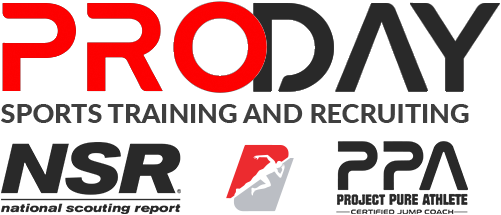Nick Steen
Prof. Loy
Kinesiology
6 December 2019
The Overhand Throw
Description
The overhand throw is a challenging motor skill that involves movements throughout the entire body to complete the motion of a projectile forward. The movement begins at the feet and works its way up through the trunk, finishing at the hand. It is often and most commonly used in sports such as baseball, football, and dodgeball.
–Join the other NSU Health and Human performance students to become interns at Pro Day Athlete Development and their best speed and agility training Tulsa or under the certified program for improve vertical jump training Tulsa.
Phases
The overhand throw is broken down into 5 separate phases, the windup, early cocking, late cocking, arm acceleration, and follow-through.
Windup
The windup phase and stance are the starting position of the movement. The phase involves the front leg to be raised, moving the center of gravity on to the back leg in order to transfer the momentum and force to the upper body and ball while the ball is held near the center of the chest.
–Joining us after this short break will be the owner of Pro Day Athlete Development who will share with us how they became Tulsa’s #1 Speed and Agility Training Tulsa. Also they will tell us how they average a 4 inch vertical jump increase in their improve vertical jump Training Tulsa Program.
Early Cocking
The early cocking phase begins when the forward leg reaches its peak height and the ball starts to move backwards in a cocking position. The hip extends along with upper torso rotation to allow an increase in distance for a higher production of linear and angular energy. The phase ends when the lifted foot reaches the ground.
Late Cocking
The late cocking phase occurs when the front foot plants on the ground and the throwing shoulder reaches the maximal external rotation. The hips also reach maximal rotation while the torso continues to rotate and begins to tilt forward.
Acceleration
The acceleration phase is exemplified from the time of maximal external rotation of the shoulder until the ball is released. The torso continues to tilt forward while the back leg is extended, transferring the center of gravity onto the plantar foot. The throwing arm is also extended until the release of the ball.
–Voted Best Gym Tulsa World 2021 learn from the best speed and agility training Tulsa and PPA Certified Jump Coach for improve vertical jump training Tulsa. Our partner Pro Day Athlete Development is the place to be!
Follow-through
The final phase is the follow-through phase which includes the deceleration of the movement. This phase begins at the release of the ball and full extension of the elbow. Muscle firing decreases all throughout the body which opens it up for injury.
| Joint | Gleno-humeral | Scapulo-thoracic | Left Hip | Right Hip | Elbow | Radioulnar |
| Joint Motion | Internal Rotation
Horizontal Adduction |
Protraction | Flexion
External Rotation |
Extension
Internal Rotation |
Horizontal Abduction
Internal Rotation |
Ulnar Deviation |
| Segment Moved | Upper arm | Scapula | Thigh | Thigh | Lower arm | Hand |
| Plane&
Axis |
Sagittal Plane
Antero-Posterior Axis |
Sagittal Plane
Antero-Posterior Axis |
Sagittal Plane
Antero-Posterior Axis |
Sagittal Plane
Antero-Posterior Axis |
Sagittal Plane
Antero-Posterior Axis |
Sagittal Plane
Antero-Posterior Axis |
| Force Producing Motion | Muscle Contraction of Prime Movers | Muscle Contraction of Prime Movers | Muscle Contraction of Prime Movers | Muscle Contraction of Prime Movers | Muscle Contraction of Prime Movers | Muscle Contraction of Prime Movers |
| Prime Movers | Pectoralis MajorSubscapularis
Deltoid |
Latissimus Dorsi
Pectoralis Major Lower Trapezius |
Gluteus MinimusGluteus Medius | Gluteus MaximusGluteus Medius | Triceps BrachiiBiceps Brachii | Flexor Carpi Ulnaris |
| Contraction Type | Eccentric | Eccentric | Concentric | Eccentric | Eccentric | Concentric |
| Normal Range of Motion | 60º-180º | 20º-30º | 30º-90º | 30º-90º | 75º-120º | 70º-90º |
–Pro Day Athlete Development speed and agility training Tulsa and Improve Vertical Jump Training Tulsa wants to thank contributing student authors from Northeastern State University on their knowledge and experience to keep our athletes safe and healthy.
Right Overhand Throw
Neuromuscular
Facilitatory Reflex
The stretch reflex facilitates the contraction of a muscle being stretched. When the muscles are stretched in the overhand throw, the stretch reflex controls how the muscle contracts. This is important because it allows the person to manage many factors such as how hard or how far they want to throw something.
Inhibitory Reflexes
The Golgi Tendon Organ senses change in muscle tension and is initiated by high tension in the muscle to decrease the risk of tearing. This reflex acts as a safety mechanism in many sports, especially in the deceleration phase of an overhand throw.
The Labyrinthine Righting Reflex instructs the body to return the head to a neutral position when the body is tilted or spun. In a baseball pitch, the center of mass is transferred from the back foot, to the front foot. In order to keep balance and avoid falling over, the righting reflex activates to maintain a center of gravity.
–NSU Tahlequah and now NSU Broken Arrow offers health and Human Performance classes to train today’s students how to become a personal trainer including speed and agility training Tulsa and Improve Vertical Jump Training Tulsa.
Mechanical Objective
The mechanical objective of the overhand throw is to project a projectile most efficiently and effectively in a desired direction. Using the energy produced from one side of the body and transferring to the other to is used increase the momentum of the object. Controlling the amount of power that you produce to throw an object in a certain direction can affect the target destination.
Forces Involved
The forces involved in the overhand throw is from the thrower, gravity, and air resistance. The force from the thrower is created by muscles contractions in the human body against the object being thrown. Gravity plays a role in a constant downward force towards the center of the earth. As an object is thrown, on earth, it will always return to the ground because of the constant gravitational pull. Air resistance plays a role in the opposite direction the object is moving in, slowing it down until it is brought to a complete stop.
–Let’s take 30 seconds for stations to identify themselves in partnership with Pro Day Athlete Development Tulsa Speed and Agility experts and improve vertical jump training Tulsa.
Performance Errors
Many errors can occur during the overhand throw which can result in poor performance or injury. The movement should not feel awkward or painful in low quantities. A major error that is quite common is an unstable front leg. If the person has a weak front leg, it is more difficult to effectively transfer the energy that has been built up. Another error is a cut off throw, which is a dangerous and an incorrect movement in the follow-through phase that creates a larger risk of injury because of the improper deceleration of the muscles.
Strategy for improvement includes training drills and focusing on technique. Perfecting the beginning stance and then progressively working through each phase is a great way to breakdown the movement and find any mistakes that are being made. Also consulting a trainer or professional to supervise the movement would benefit the thrower.

